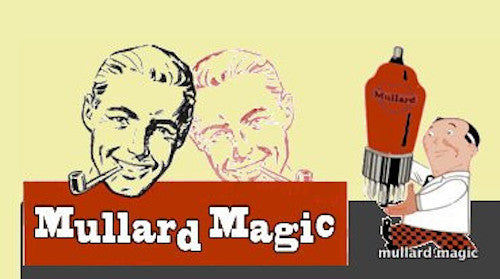
TELEFUNKEN
Share


Around the turn of the 20th century, two groups of German researchers worked on the development of techniques for wireless communication. The one group at AEG, led by Adolf Slaby and Georg Graf von Arco, developed systems for the German Navy; the other one, under Karl Ferdinand Braun, at Siemens, for the German Army.
When a dispute concerning patents arose between the two companies, Kaiser Wilhelm II urged both parties to join efforts, creating Gesellschaft für drahtlose Telegraphie System Telefunken ("The Company for Wireless Telegraphy Ltd.") joint venture on 27 May 1903, with the disputed patents and techniques invested in it. On 17 April 1923, it was renamed Telefunken, The Company for Wireless Telegraphy. Telefunken was the company's telegraph address. The first technical director of Telefunken was Georg Graf von Arco.
Starting in 1923, Telefunken built broadcast transmitters and radio sets.
In 1928, Telefunken made history by designing the V-41 amplifier for the German Radio Network. This was the very first two stage, "Hi-Fi" amplifier. Over time, Telefunken perfected their designs and in 1950 the V-72 amplifier was developed. The TAB (a manufacturing subcontractor to Telefunken) V-72 soon became popular with other radio stations and recording facilities. The V-72S was the only type of amplifier found in the REDD-37 console used by the Beatles at Abbey Road Studios on every recording prior to Rubber Soul. In 1932, record players were added to the product line.
In 1941 Siemens transferred its Telefunken shares to AEG as part of the agreements known as the "Telefunken settlement", and AEG thus became the sole owner and continued to lead Telefunken as a subsidiary (starting in 1955 as "Telefunken GmbH" and from 1963 as "Telefunken AG").
During the Second World War Telefunken was a supplier of vacuum tubes, transmitters and radio relay systems, and developed radar facilities and directional finders, aiding extensively to the German air defence against British-American Aerial Bombing. During the war, manufacturing plants were shifted to and developed in west of Germany or relocated. Thus, Telefunken, under AEG, turned into the smaller subsidiary, with the three divisions realigning and data processing technology, elements as well as broadcast, television and phono. Telefunken was also the originator of the FM radio broadcast system. Telefunken, through the subsidiary company Teldec (a joint venture with Decca Records), was for many decades one of the largest German record companies, until Teldec was sold to WEA in 1988.
In 1959, Telefunken established a modern semiconductor works in Heilbronn, where in April 1960 production began. The works was expanded several times, and in 1970 a new 6-storey building was built at the northern edge of the area. At the beginning of the 1970s it housed approximately 2,500 employees.
In 1967, Telefunken was merged with AEG, which was then renamed to AEG-Telefunken. During this era, Walter Bruch developed the PAL color television for the company, in use by most countries outside the Americas today (i.e. United Kingdom - PAL-I), and by Brazil (PAL-M) and Argentina (PAL-N) in South America.
The mainframe computer TR 4 was developed at Telefunken in Backnang, and the TR 440 model was developed at Telefunken in Konstanz. They were in use at many German university computing centres from the 1970s to around 1985. The development and manufacture of large computers was separated in 1974 to the Konstanz Computer Company (CGK). The production of mini- and process computers was integrated into the automatic control engineering division of AEG. When AEG was bought by Daimler in 1985, "Telefunken" was dropped from the company name.
In 2005, Telefunken Sender Systeme Berlin changed its name to Transradio SenderSysteme Berlin AG. The name "Transradio" dates back to 1918, when Transradio was founded as a subsidiary of Telefunken. A year later, in 1919, Transradio made history by introducing duplex transmission. Transradio has specialized in research, development and design of modern AM, VHF/FM and DRM broadcasting systems.
In August 2006, it acquired the Turkish company Profilo Telra, one of the largest European manufacturers of TV-devices, with Telefunken GmbH granting a license for the Telefunken trademark rights and producing televisions under that name. In 2000, Toni Roger Fishman acquired The Diamond Shaped Logo & The Telefunken Brand Name for use in North America. The company "Telefunken USA" [1] was incorporated in early 2001 to provide restoration services and build exact reproductions of vintage Telefunken microphones. In 2003, Telefunken USA won a TEC Award for Studio Microphone Technology for their exact reproduction of the original Ela M 250 / 251 Microphone system. Telefunken USA has since received several TEC Awards nominations for the following microphone systems: the Telefunken USA M12 or C12 (originally developed by AKG), the R-F-T M16 MkII, and the AK47. The Historic Telefunken Ela M251 microphone system entered the MIX foundation's Hall of fame in 2006. In 2008, Telefunken USA won a second TEC Award for its new Ela M 260 microphone.
As a result of a conference held in Frankfurt in May 2009, Telefunken USA has been renamed Telefunken Elektroakustik ("Electrical Acoustics") Division of Telefunken and awarded the exclusive rights to manufacture a wide variety of professional audio products and vacuum tubes bearing the Telefunken Trade Mark, in over 27 countries. Telefunken Elektroakustik now uses the Telefunken trademark for Professional Audio Equipment & Component Based Electronics, such as Capacitors, Transformers, Vacuum Tubes in Asia, Australia, Europe, North America and South America
